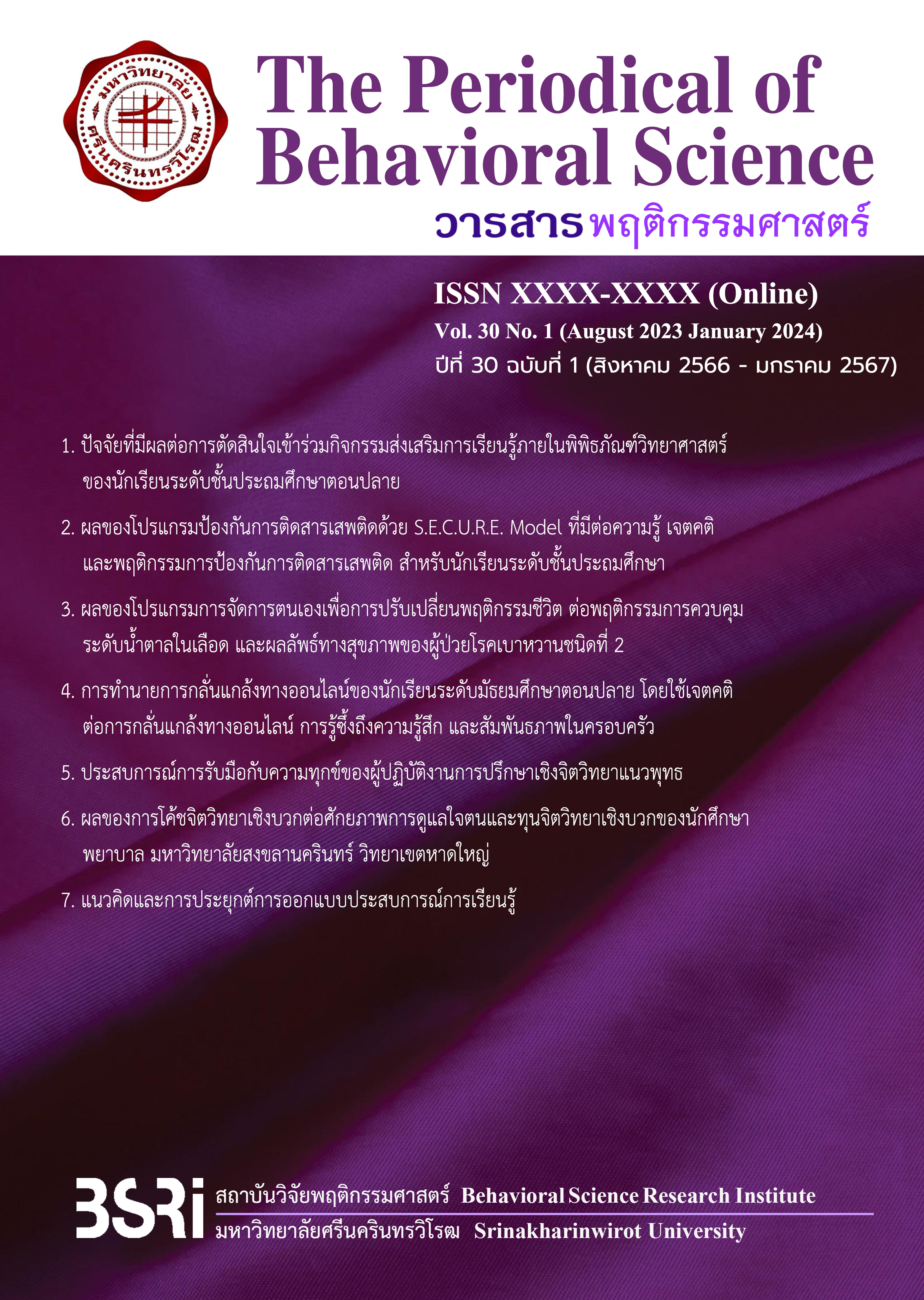The Impact of the Substance Abuse Prevention Program using the S.E.C.U.R.E. Model on Knowledge, Attitudes, and Behaviors in the Prevention of Substance Addiction among Elementary School Students
Keywords:
elementary school students, substance addiction, substance addiction preventionAbstract
The problem of drug addiction has been a serious threat in Thai society for a long time. The purpose of this research is to study the effectiveness of the S.E.C.U.R.E. Model-based prevention program on knowledge, attitudes, and behaviors in preventing substance abuse in the post-experiment phase between the experimental and control groups, using experimental research. The sample group consisted of 60 primary school students, randomly divided into an experimental group of 30 and a control group of 30, using group randomization. The research tools included basic information questionnaires, assessments of knowledge in substance abuse prevention, assessments of attitudes towards substance abuse prevention, assessments of behaviors in substance abuse prevention, and the substance abuse prevention program using the S.E.C.U.R.E. model. Data were analyzed using the analysis of variance and covariance. The study found that after the experiment, students in the experimental group had significantly higher knowledge and attitudes towards substance abuse prevention than students in the control group at a significance level of .05. However, there was no significant difference in the behavior of substance abuse prevention between the experimental and control groups at a significance level of .05. This S.E.C.U.R.E. Model substance abuse prevention program can be applied by organizations and individuals working with drug addiction prevention in children and adolescents to suit the nature of learning and context in the area.
Downloads
References
Akça, S. Ö, & Turan, A. P. (2023). Substance abuse and its prevention in adolescents. Addicta: The Turkish Journal on Addictions, 10(1), 86-92. https://www.addicta.com.tr/Content/files/sayilar/35/ADDCT_20220084%2086-92%20(2).pdf
Au, W. C. C., & Kennedy, K. J. (2018). A Positive Education Program to Promote Wellbeing in Schools: A Case Study from a Hong Kong School. Higher Education Studies, 8(4), 9-22.
Bourduge, C., Brousse, G., Morel, F., Pereira, B., Lambert, C., Izaute, M., & Teissedre, F. (2022). Intervention Program Based on Self: A Proposal for Improving the Addiction Prevention Program Unplugged through Self-Concept. International Journal of Environmental Research and Public Health, 19(15), 8994. https://doi.org/10.3390/ijerph19158994
Chotiwarangkul, N. (2022). Evaluation of Knowledge, Attitude towards Drug Use and Drug Therapy in Drug Treatment Program at Sawanpracharak Hospital, Nakhonsawan. Region 3 Medical and Public Health Journal, 19(3), 236-257.
Eko, A. B., Anitah, M. S., & Suryani, N. (2018). Utilization of interactive multimedia for drug abuse prevention in social studies at elementary schools. The 2nd International Conference on Technology, Education, and Social Science 2018 (The 2nd ICTESS 2018), 180 -184. https://ejurnal.unisri.ac.id/index.php/proictss/article/view/2161
Glanz, K., Rimer, B. K., & Viswanath, K. (2008). Health behavior and health Education: Theory, research, and practice. Jossy-Bass.
Kanato, M., & Leyatikul, P. (2023). Substances Use among Thai Teenager, 2022. ONCB Journal, 39(1), 34-45. https://www.oncb.go.th/EN_ONCB/Pages/publications.aspx
Kucharoen, A. (2023). The Causal Factors of Thai Teenager’s Drug Addiction Behavior: Analysis of Model Invariance between Male and Female Adolescents. Journal of Roi Kaensarn Academi, 8(5), 235-255. https://so06.tci-thaijo.org/index.php/IJBS/article/view/257842
Layman, H. M., Thorisdottir, I. E., Halldorsdottir, T., Sigfusdottir, I. D., Allegrante, J. P., & Kristjansson, A. L. (2022). Substance Use Among Youth During the COVID-19 Pandemic: A Systematic Review. Current Psychiatry Reports, 24(6), 307-324. https://doi.org/10.1007/s11920-022-01338-z
Medina-Mora, M. E. (2005). Prevention of substance abuse: A brief overview. World Psychiatry, 4(1), 25-30. https://www.ncbi.nlm.nih.gov/pmc/articles/PMC1414714/
Naiyaphat, O. (2005). Quantitative and qualitative research methods in behavioral sciences and social sciences. Pimlak. [in Thai]
Nawi, A. M., Ismail, R., Ibrahim, F., Hassan, M. R., Manaf, M. R. A., Amit, N., Ibrahim, N., & Shafurdin, N. S. (2021). Risk and protective factors of drug abuse among adolescents: A systematic review. BMC Public Health, 21(1), 2088. https://doi.org/10.1186/s12889-021-11906-2
Phuangphae, P. (2017). Creativity-based learning in Social Studies. Veridian E-Journal, Silpakorn University, 10(5), 365-374.
Rheu, M. (2020). Attitude. In J. Bulck (Ed.), The International Encyclopedia of Media Psychology. https://doi.org/10.1002/9781119011071.iemp0181
Ruechaipanit, W. (2015). Creativity-based Learning (CBL). Walailak Journal of Learning Innovations, 1(2), 23-37. https://so03.tci-thaijo.org/index.php/jliwu/article/view/95056
Seligman, M. (2011). Flourish: A Visionary New Understanding of Happiness and Well-being. Free Press.
Siriwatanamethanon, J., Nuntaboot, K., Buatee, S., Aryamuang, S., & Dodgson, J. L. A. (2012). Strategies to Prevent Drug Abuse among Primary School Students. International Journal of Behavioral Science, 7(1), 59-72. https://doi.org/10.14456/ijbs.2012.4
Srisengthong, P. (2019). Factors to Enhance the Effectiveness of the Working Approach of Drug Addiction Prevention in Bangkok, Thailand. International Journal of Criminal Justice Sciences, 14(2), 99-119. https://doi.org/10.5281/zenodo.3712041
Substance use prevention services. (2022). Prevention standards and practices manual. http://publichealth.lacounty.gov/sapc/prevention/PV/PreventionStandardsManual.pdf
Tremblay, M., Baydala, L., Khan, M., Currie, C., Morley, K., Burkholder, C., Davidson, R., & Stillar, A. (2020). Primary Substance Use Prevention Programs for Children and Youth: A Systematic Review. Pediatrics, 146(3), e20192747. https://doi.org/10.1542/peds.2019-2747
United Nations Office on Drug and Crime. (2023). World Drug Report 2023. United Nations publication.
Ubonsai, K., Charoensuk, O., & Voracharoensri, S. (2018). Psycho-Social Factors correlating with Drugs Abuse Preventive Behaviors among Thai Adolescence: Application of Meta-Analysis. Journal of Behavioral Science for Development, 10(2), 21-40. https://so02.tci-thaijo.org/index.php/JBSD/article/view/122402
Warren, J. A., Hof, K. R., McGriff, D., & Morris, L. N. B. (2012). Five experiential learning activities in addictions education. Journal of Creativity in Mental Health, 7(3), 272-288. https://www.tandfonline.com/doi/abs/10.1080/15401383.2012.710172?journalCode=wcmh20
Winters, K. C., Fahnhorst, T., Botzet, A., Lee, S., & Lalone, B. (2012). Brief intervention for drug-abusing adolescents in a school setting: Outcomes and mediating factors. Journal of Substance Abuse Treatment, 42, 279–288. https://doi.org/10.1016/j.jsat.2011.08.005
Downloads
Published
How to Cite
Issue
Section
License
Copyright (c) 2024 Warasan Phuettikammasat

This work is licensed under a Creative Commons Attribution-NonCommercial-NoDerivatives 4.0 International License.
Behavioral Science Research Institute, SWU
114 Sukhumvit 23, Bangkok 10110, Thailand.
Tel.02-649-5000 # 17600



